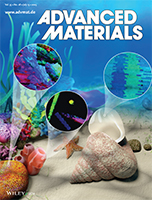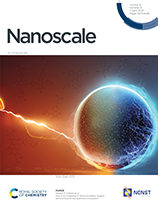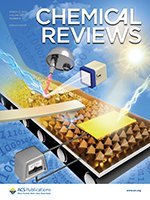Researchers achieve power conversion efficiencies approaching 10% by careful control of the nanoparticle and thin film morphologies thanks to surface energy considerations. This approach opens the route to low environmental footprint photovoltaics. Representing the promise of this sustainable direction in organic photovoltaics, the image shows the deposition of the active layer from water-based nanoparticles inks. Read more »
Journal Covers
Allosteric Tuning of Caspase-7: Establishing the Nexus of Structure and Catalytic Power
How can allosteric sites be more effectively targeted by small-molecule drugs? Using an integrated in vitro/in silico experimental workflow; we discovered novel allosteric inhibitors of caspase-7 and revealed new connections between the active site and the remote allosteric site (i. e., allosteric structure–activity relationships, ASARs) for this valuable disease target. Read more »
A Molecular-Scale Understanding of Misorientation Toughening in Corals and Seashells
Researchers reveal that the toughness of polycrystalline seashells and coral skeletons is increased by small misorientation of adjacent crystals. The findings pave the way toward bioinspired materials with tunable toughness. Read more »
Impact of Thermal Stress on Device Physics and Morphology in Organic Photodetectors
Implementing organic photodetectors (OPDs) into Si-based manufacturing process requires high thermal resistance. This work showcases a comprehensive picture of the impact of high thermal stress (at 200 °C, up to 2 hours) on photosensing performance, bulk and interfacial morphologies, and device physics. Read more »
Vertical Gradient of Size-Resolved Aerosol Compositions over the Arctic Reveals Cloud Processed Aerosol in-Cloud and above Cloud
Vertical distribution of size-resolved chemical composition of Arctic aerosol particles was investigated in different cloud layers. Multimodal microspectroscopy analysis reveals a broadening of chemically-specific size distribution above the cloud top. Read more »
Sub-4 nm mapping of donor–acceptor organic semiconductor nanoparticle composition
We report, for the first time, sub-4 nm mapping of donor : acceptor nanoparticle composition in eco-friendly colloidal dispersions for organic electronics. This technology shows great promise for the optimization of organic semiconductor blends for organic electronics and photocatalysis and has further applications in organic core–shell nanomedicines. Read more »
The Identity and Chemistry of C7H7 Radicals Observed during Soot Formation
Recent work suggests that resonance-stabilized radicals may participate in chain reactions that lead to soot-particle formation, but their identities and chemistry are poorly understood. C7H7 is often observed in aerosol mass spectra and is generally assumed to be benzyl, the most thermodynamically stable C7H7 isomer. It has now been shown that the identities of these isomers are far more varied, and their chemistry is far more complex, than previously appreciated. Read more »
SO2 Photodissociation at 193 nm Directly Forms S(3P) + O2(3Σg–): Implications for the Archean Atmosphere on Earth
Sulfur isotope patterns in ancient rock layers inform our understanding of Earth’s Archean atmosphere. Before the Great Oxygenation Event (~2.4 billion years ago), hard ultraviolet light penetrated into the Earth’s surface, photodissociating sulfur dioxide directly to S + O2. This new product channel may help resolve discrepancies in the Earth’s evolutionary history. Read more »
Raman and Far-Infrared Synchrotron Nanospectroscopy of Layered Crystalline Talc: Vibrational Properties, Interlayer Coupling, and Symmetry Crossover
Talc is an electrical insulator and an excellent target for low-cost, heterostructure-based optoelectronic applications. Here, light-matter interactions and their consequences at the nanoscale-thickness limit are probed using Raman spectroscopy, near-field synchrotron infrared nanospectroscopy, and first-principles calculations. Read more »
In Situ and Operando Characterizations of Metal Halide Perovskite and Solar Cells: Insights from Lab-Sized Devices to Upscaling Processes
The performance and stability of metal halide perovskite solar cells strongly depend on precursor materials and deposition methods adopted during the perovskite layer preparation. This review presents an update of studies conducted in situ using a wide range of structural, imaging, and spectroscopic techniques, involving the formation/degradation of halide perovskites. Read more »
- « Previous Page
- 1
- …
- 3
- 4
- 5
- 6
- 7
- …
- 21
- Next Page »









